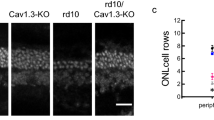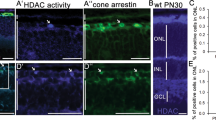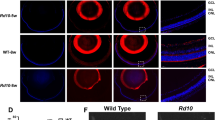Abstract
Retinitis pigmentosa (RP) is a degenerative retinal disease involving progressive loss of rod and cone photoreceptor function. It represents the most common form of registered blindness among the working aged populations of developed countries. Given the immense genetic heterogeneity associated with this disease, parameters influencing cone photoreceptor survival (preservation of daytime vision) that are independent of primary mutations are exceedingly important to identify from a therapeutic standpoint. Here we identify C1q, the primary component of the classical complement pathway, as a cone photoreceptor neuronal survival factor.
Similar content being viewed by others
Log in or create a free account to read this content
Gain free access to this article, as well as selected content from this journal and more on nature.com
or
References
RetNet: The Retinal Information Network. http://www.sph.uth.tmc.edu/RetNet Stephen P Daiger, PhD, Administrator, The Univ. of Texas Health Science Center at Houston, 1996–present.
Heckenlively JR : Retinitis Pigmentosa. JB Lippincott: Philadelphia, PA, USA, 1988.
Bainbridge JW, Smith AJ, Barker SS et al: Effect of gene therapy on visual function in Leber's congenital amaurosis. N Engl J Med 2008; 358: 2231–2239.
Maguire AM, Simonelli F, Pierce EA et al: Safety and efficacy of gene transfer for Leber's congenital amaurosis. N Engl J Med 2008; 358: 2240–2248.
Hauswirth WW, Aleman TS, Kaushal S et al: Treatment of leber congenital amaurosis due to RPE65 mutations by ocular subretinal injection of adeno-associated virus gene vector: short-term results of a phase I trial. Hum Gene Ther 2008; 19: 979–990.
Acland GM, Aguirre GD, Ray J et al: Gene therapy restores vision in a canine model of childhood blindness. Nat Genet 2001; 28: 92–95.
Smith AJ, Schlichtenbrede FC, Tschernutter M, Bainbridge JW, Thrasher AJ, Ali RR : AAV-mediated gene transfer slows photoreceptor loss in the RCS rat model of retinitis pigmentosa. Mol Ther 2003; 8: 188–195.
Tschernutter M, Schlichtenbrede FC, Howe S et al: Long-term preservation of retinal function in the RCS rat model of retinitis pigmentosa following lentivirus-mediated gene therapy. Mol Ther 2005; 12: 694–701.
Pawlyk BS, Smith AJ, Buch PK et al: Gene replacement therapy rescues photoreceptor degeneration in a murine model of Leber congenital amaurosis lacking RPGRIP. Invest Ophthalmol Vis Sci 2005; 46: 3039–3045.
Kiang AS, Palfi A, Ader M et al: Toward a gene therapy for dominant disease: validation of an RNA interference-based mutation-independent approach. Mol Ther 2005; 12: 555–561.
Min SH, Molday LL, Seeliger MW et al: Prolonged recovery of retinal structure/function after gene therapy in an Rs1h-deficient mouse model of x-linked juvenile retinoschisis. Mol Ther 2005; 2: 644–651.
Jacobson SG, Acland GM, Aguirre GD et al: Safety of recombinant adeno-associated virus type 2-RPE65 vector delivered by ocular subretinal injection. Mol Ther 2006; 13: 1074–1084.
Hashimoto T, Gibbs D, Lillo C et al: Lentiviral gene replacement therapy of retinas in a mouse model for Usher syndrome type 1B. Gene Ther 2007; 14: 584–594.
Alexander JJ, Umino Y, Everhart D et al: Restoration of cone vision in a mouse model of achromatopsia. Nat Med 2007; 13: 685–687.
O’Reilly M, Palfi A, Chadderton N et al: RNA interference-mediated suppression and replacement of human rhodopsin in vivo. Am J Hum Genet 2007; 81: 127–135.
Kong J, Kim SR, Binley K et al: Correction of the disease phenotype in the mouse model of Stargardt disease by lentiviral gene therapy. Gene Ther 2008; 15: 1311–1320.
Pang JJ, Boye SL, Kumar A et al: AAV-mediated gene therapy for retinal degeneration in the rd10 mouse containing a recessive PDEbeta mutation. Invest Ophthalmol Vis Sci 2008; 49: 4278–4283.
Tam LC, Kiang AS, Kennan A et al: Therapeutic benefit derived from RNAi-mediated ablation of IMPDH1 transcripts in a murine model of autosomal dominant retinitis pigmentosa (RP10). Hum Mol Genet 2008; 17: 2084–2100.
Tan MH, Smith AJ, Pawlyk B et al: Gene therapy for retinitis pigmentosa and Leber congenital amaurosis caused by defects in AIPL1: effective rescue of mouse models of partial and complete Aipl1 deficiency using AAV2/2 and AAV2/8 vectors. Hum Mol Genet 2009; 18: 2099–2114.
Sun X, Pawlyk B, Xu X et al: Gene therapy with a promoter targeting both rods and cones rescues retinal degeneration caused by AIPL1 mutations. Gene Ther 2009; 17: 117–131.
Komáromy AM, Alexander JJ, Rowlan JS et al: Gene therapy rescues cone function in congenital achromatopsia. Hum Mol Genet 2010; 19: 2581–2593.
Tam LC, Kiang AS, Campbell M et al: Prevention of autosomal dominant retinitis pigmentosa by systemic drug therapy targeting heat shock protein 90 (Hsp90). Hum Mol Genet 2010; 19: 4421–4436.
Li X, Li W, Dai X et al: Gene therapy rescues cone structure and function in the 3-month-old rd12 mouse: a model for midcourse RPE65 leber congenital amaurosis. Invest Ophthalmol Vis Sci 2011; 52: 7–15.
Edwards AO, Malek G : Molecular genetics of AMD and current animal models. Angiogenesis 2007; 10: 119–132.
Yates JRW, Sepp T, Baljinder KM et al: Complement C3 variant and the risk of age-related macular degeneration. N Engl J Med 2007; 357: 19–27.
Maller JB, Fagerness JA, Reynolds RC, Neale BM, Daly MJ, Seddon JM : Variation in complement factor 3 is associated with risk of age-related macular degeneration. Nat Genet 2007; 39: 1200–1201.
Haines JL : C3 R102G polymorphism increased risk of age-related macular degeneration. Hum Mol Genet 2008; 17: 1821–1824.
Schultz DW, Klein ML, Humpert AJ et al: Analysis of the ARMD1 locus: evidence that a mutation in HEMICENTIN-1 is associated with age-related macular degeneration in a large family. Hum Mol Genet 2003; 12: 3315–3323.
Stone EM, Braun TA, Russell SR et al: Missense variations in the fibulin 5 gene and age-related macular degeneration. N Engl J Med 2004; 351: 346–353.
Canter JA, Olson LM, Spencer K et al: Mitochondrial DNA polymorphism A4917G is independently associated with age-related macular degeneration. PLoS ONE 2008; 3: e2091.
Marmor M, Cabael L, Shukla S, Hwang JC, Marcus M : Clinical S-cone ERG recording with a commercial hand-held full-field stimulator. Doc Ophthalmol 2004; 108: 107–114.
Humphries MM, Rancourt D, Farrar GJ et al: Retinopathy induced in mice by targeted disruption of the rhodopsin gene. Nat Genet 1997; 15: 216–219.
Botto M, Dell’Agnola C, Bygrave AE et al: Homozygous C1q deficiency causes glomerulonephritis associated with multiple apoptotic bodies. Nat Genet 1998; 19: 56–59.
Humphries MM, Kiang A-S, McNally N et al: Comparative structural and functional analysis of photoreceptor neurons of Rho−/− mice reveal increased survival on C57BL/6J in comparison to 129Sv genetic background. Vis Neurosci 2001; 18: 437–443.
Toda K, Bush RA, Humphries P, Sieving PA : The electroretinogram of the rhodopsin knockout mouse. Vis Neurosci 1999; 16: 391–398.
Baruah P, Simpson E, Dumitriu IE et al: Mice lacking C1q or C3 show accelerated rejection of minor H disparate skin grafts and resistance to induction of tolerance. Eur J Immunol 2010; 40: 1758–1767.
Punzo C, Kornacker K, Cepko CL : Stimulation of the insulin/mTOR pathway delays cone death in a mouse model of retinitis pigmentosa. Nat Neurosci 2009; 12: 44–52.
Schlichtenbrede FC, MacNeil A, Bainbridge JW et al: Intraocular gene delivery of ciliary neurotrophic factor results in significant loss of retinal function in normal mice and in the Prph2Rd2/Rd2 model of retinal degeneration. Gene Ther 2003; 10: 523–527.
Talcott KE, Ratnam K, Sundquist SM et al: Longitudinal study of cone photoreceptors during retinal degeneration and in response to ciliary neurotrophic factor treatment. Invest Ophthalmol Vis Sci 2011; 52: 2219–2226.
Mohand-Said S, Deudon-Combe A, Hicks D et al: Normal retina releases a diffusible factor stimulating cone survival in the retinal degeneration mouse. Proc Natl Acad Sci USA 1998; 95: 8357–8362.
Fintz AC, Audo I, Hicks D, Mohand-Said S, Léveillard T, Sahel J : Partial characterization of retina-derived cone neuroprotection in two culture models of photoreceptor degeneration. Invest Ophthalmol Vis Sci 2003; 44: 818–825.
Léveillard T, Sahel JA : Rod-derived cone viability factor for treating blinding diseases: from clinic to redox signaling. Sci Transl Med 2010; 2: 26ps16.
Cronin T, Raffelsberger W, Lee-Rivera I et al: The disruption of the rod-derived cone viability gene leads to photoreceptor dysfunction and susceptibility to oxidative stress. Cell Death Differ 2010; 17: 1199–1210.
Yang Y, Mohand-Said S, Danan A et al: Functional cone rescue by RdCVF protein in a dominant model of retinitis pigmentosa. Mol Ther 2009; 17: 787–795.
Klein RJ, Zeiss C, Chew EY et al: Complement factor H polymorphism in age-related macular degeneration. Science 2005; 308: 363–364.
Edwards AO, Ritter R, Abel KJ, Manning A, Panhuysen C, Farrer LA : Complement factor H polymorphism and age-related macular degeneration. Science 2005; 308: 421–424.
Haines JL, Hauser MA, Schmidt S et al: Complement factor H variant increases the risk of age-related macular degeneration. Science 2005; 308: 419–421.
Navratil JS, Watkins SC, Wisnieski JJ, Ahearn JM : The globular heads of C1q specifically recognize surface blebs of apoptotic vascular endothelial cells. J Immunol 2001; 166: 3231–3239.
Trouw LA, Blom AM, Gasgue P : Role of complement and complement regulators in the removal of apoptotic cells. Mol Immunol 2008; 45: 1199–1207.
Nauta AJ, Trouw LA, Daha MR et al: Direct binding of C1q to apoptotic cells and cell blebs induces complement activation. Eur J Immunol 2002; 32: 1726–1736.
Portera-Cailliau C, Sung CH, Nathans J, Adler R : Apoptotic photoreceptor cell death in mouse models of retinitis pigmentosa. Proc Natl Acad Sci USA 1994; 91: 974–978.
Sunaief JL, Dentchev T, Ying GS, Milam AH : The role of apoptosis is age-related macular degeneration. Arch Ophthalmol 2002; 120: 1435–1442.
Rohrer B, Demos C, Frigg R, Grimm C : Classical complement activation and acquired immune response pathways are not essential for retinal degeneration in the rd1 mouse. Exp Eye Res 2007; 84: 82–91.
Acknowledgements
The Ocular Genetics Unit at TCD is supported by Science Foundation Ireland, Health Research Board of Ireland, EVI-Genoret (LSHG-CT-2005-512036) and Fighting Blindness Ireland. We would like to thank Ms Caroline Woods and Mr Charles Murray for animal husbandry.
Author information
Authors and Affiliations
Corresponding author
Ethics declarations
Competing interests
The authors declare no conflict of interest.
Rights and permissions
About this article
Cite this article
Humphries, M., Kenna, P., Campbell, M. et al. C1q enhances cone photoreceptor survival in a mouse model of autosomal recessive retinitis pigmentosa. Eur J Hum Genet 20, 64–68 (2012). https://doi.org/10.1038/ejhg.2011.151
Received:
Revised:
Accepted:
Published:
Issue date:
DOI: https://doi.org/10.1038/ejhg.2011.151
Keywords
This article is cited by
-
Subretinal macrophages produce classical complement activator C1q leading to the progression of focal retinal degeneration
Molecular Neurodegeneration (2018)



